Best Buy isn’t just a consumer electronics giant; it’s a data-driven retail leader. Beyond the iconic blue and yellow stores, their success hinges on a sophisticated marketing strategy fueled by customer insights. By combining a data-driven approach with a strong omnichannel presence, Best Buy has transformed its marketing mix into a competitive advantage. Their success serves as a blueprint for other retailers seeking to thrive in today’s dynamic market. This case study delves into the significant impact of Best Buy’s marketing initiatives, highlighting their role in driving the company’s remarkable success.
By the end of 2023, Best Buy boasted a staggering $43.45 billion in total revenue. A significant portion, $18.674 million in FY 2023, came from e-commerce and online sales. This achievement underscores Best Buy’s mastery of the digital landscape, leveraging technology to expand its reach and deepen customer engagement. At the heart of Best Buy’s triumph lies its unwavering commitment to customer-centric practices. The company has crafted an engaging brand experience that resonates with consumers by seamlessly blending traditional marketing tactics with innovative digital initiatives. From captivating advertisements to interactive social media campaigns, Best Buy consistently fosters meaningful connections with its audience, cultivating loyalty and brand advocacy.
Going mobile? So is our content — listen now.
Highlights of Best Buy’s marketing strategy
- Customer-centric approach: Best Buy prioritizes understanding and meeting diverse customer needs to cultivate lasting satisfaction and loyalty.
- Tailored and personalized services and products: The brand focuses on customizing offerings based on individual preferences and feedback to enhance customer engagement.
- Customer engagement strategies: The Best Buy marketing strategy employs targeted advertising, digital marketing, and loyalty programs to connect with customers effectively.
- Strategic partnerships: The company collaborates with brands and engages with communities to strengthen its position as a trusted retailer.
- Omnichannel retailing: One of the most important aspects of Best Buy’s marketing approach is seamlessly integrating online and in-store experiences, allowing customers to shop conveniently across various channels.
- Technology and innovation: Best Buy has made some significant investments in the latest technologies like AI and VR to enhance the shopping experience and stay ahead of competitors.
- Brand partnerships and exclusives: Strategic collaborations with top brands to offer exclusive deals and products, is one of the key points that differentiates Best Buy from its competitors.
- Efficient use of customer data: Best Buy collects and analyzes customer data and market trends to personalize marketing campaigns and improve overall customer experience.
- Expert advice and services: The company’s employees provide knowledgeable assistance in-store and through digital channels to build trust and enhance the shopping experience.
- Cost management and efficiency: Focusing on operational efficiency and cost-effective delivery, Best Buy maintains competitive pricing and profitability.
Best Buy: The business profile of the largest US consumer electronics retailer
Historical background
Founding years (1966-1980s)
Best Buy’s origins date back to 1966 when Richard M. Schulze and a partner established an audio specialty store named Sound of Music in Saint Paul, Minnesota. Initially focusing on stereo systems, the store gained local prominence. In 1978, a tornado damaged Sound of Music, prompting Schulze to organize a successful “Tornado Sale” that outperformed typical monthly earnings. This triumph led to a rebranding in 1983, marking the birth of Best Buy Company, Inc. The company went public in 1985, facing competitive challenges in 1988 but introducing innovative store concepts like “Concept II.”
Expansion and growth (1990s-2000s)
By 1992, Best Buy achieved $1 billion in annual revenues, while its competitor, Highland, faced bankruptcy. Best Buy embarked on innovative store concepts like “Concept III” and “Concept IV,” solidifying its position in the retail realm. Inclusion in Standard & Poor’s S&P 500 index in 1999 affirmed its retail prowess.
Diversification and acquisitions (2000s-2010s)
In subsequent years, Best Buy diversified into services like the Geek Squad and expanded internationally, acquiring companies like Future Shop Ltd. and Jiangsu Five Star Appliance. Strategic acquisitions further enhanced its market presence, with notable additions including Magnolia Hi-Fi, Geek Squad, Speakeasy, and Napster.
Challenges and restructuring (2010s-present)
Facing challenges from online retailers, Best Buy underwent strategic initiatives in the 2010s. This included store closures, cost-cutting measures, and a focus on improving customer experiences both in-store and online. Investments in omnichannel capabilities aimed to adapt to evolving consumer behaviors and maintain competitiveness.
Interesting charts about Best Buy
Best Buy’s revenue share by segment
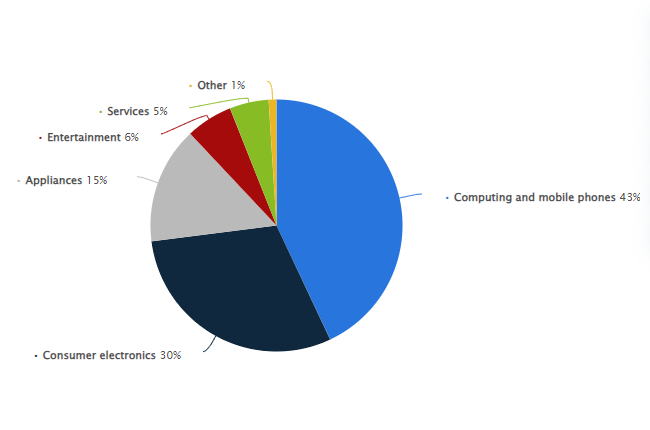
Best Buy’s eCommerce revenue evolution
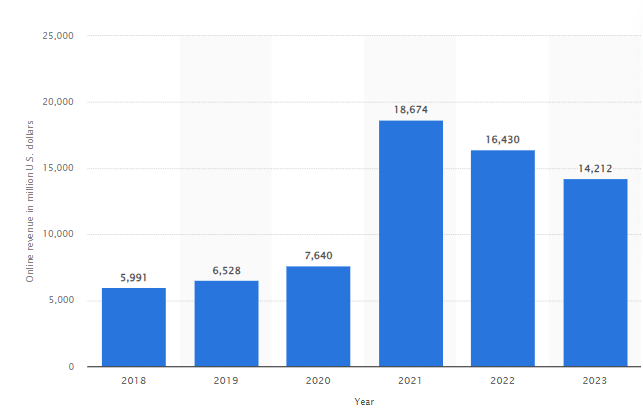
Key components of Best Buy’s marketing strategy
By focusing on exceptional customer experiences, the brand stays at the forefront of technological advancements and offers exclusive products that resonate with its target audience. The Best Buy marketing strategy ultimately focuses on driving customer engagement, loyalty, and sales in the competitive consumer electronics retail market.
Customer-centric approach: Understanding and prioritizing customer needs and feedback

Best Buy aims to connect with its target audience, offer personalized experiences, and reinforce its position as a trusted and innovative retailer.
- Customer-centric approach: Best Buy prioritizes understanding and meeting diverse customer needs to cultivate lasting satisfaction and loyalty.
- Tailored services and products: Best Buy customizes offerings based on individual preferences and feedback to enhance customer engagement.
- Customer engagement strategies: Best Buy employs targeted advertising, digital marketing, and loyalty programs like “My Best Buy” to connect with customers.
- Strategic partnerships: Collaborating with brands and engaging with communities strengthens Best Buy’s position as a trusted retailer.
- Expert advice: Best Buy provides knowledgeable assistance in-store, reinforcing its commitment to personalized experiences and innovation.
Omnichannel retailing: Integration of online and in-store shopping experiences
By blending online and offline shopping experiences seamlessly, the Best Buy marketing strategy has managed to maintain its leading position in the consumer electronics retail industry.
- Omnichannel retailing: Best Buy seamlessly integrates online and in-store experiences, allowing customers to browse, purchase, and receive products through multiple channels.
- Effortless product research online: A user-friendly website and robust mobile app allow for in-depth product comparisons and detailed information access.
- Convenient in-store pickup: Customers can research online and then effortlessly pick up their purchases at a nearby store, saving valuable time.
- Trained in-store associates: Knowledgeable staff provides personalized advice, bridging the online research gap and fostering trust.
- Flexibility and convenience: Customers can shop via physical stores, online platforms, or mobile apps, ensuring a consistent and convenient experience.
Technology and innovation: Investing in the latest technologies to enhance customer experience
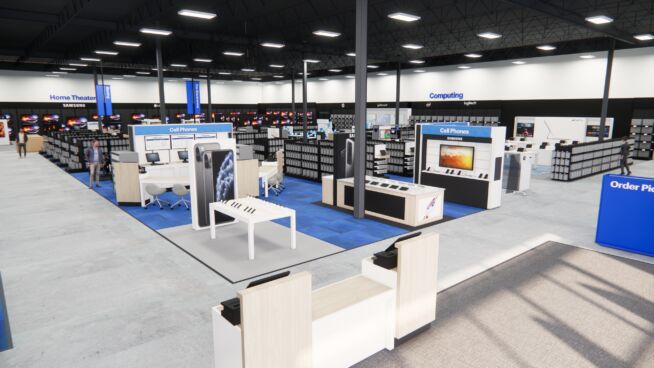
By investing in digital innovations, Best Buy provides a seamless online shopping experience, personalized recommendations, and efficient customer service across digital channels. These digital initiatives contribute to creating a more engaging and convenient shopping experience for customers.
AI integration
Best Buy integrates Artificial Intelligence (AI) into its operations to streamline processes, reduce costs, and foster growth. Through AI technologies, the company optimizes customer care processes, enhances operational efficiencies, and delivers a seamless multichannel customer experience. The primary objectives of AI implementation at Best Buy include personalizing interactions, improving service quality, and increasing customer satisfaction.
Implementation of generative AI
In addition to AI, Best Buy has implemented Generative AI to summarize main points from customer interactions. This technology effectively reduces call times, allowing agents to focus more on addressing customer needs. By enhancing the efficiency of customer care processes, Generative AI contributes to improved agent satisfaction and a smoother customer service experience.
Initiatives in virtual reality (VR) training
Best Buy also embraces Virtual Reality (VR) training initiatives, particularly for in-home consultants and designers. Piloting VR training programs aims to elevate specialized selling skills among staff members. By leveraging VR technology, Best Buy seeks to improve sales techniques, reduce training costs, and enhance employee skills and customer interactions.
Adoption of innovative communication tools
Moreover, Best Buy adopts innovative communication tools, such as Rich Communication Services (RCS), to enhance customer connections. Customers receive detailed product information, personalized messaging, and interactive communication options through these technologies, deepening engagement.
Brand partnerships and exclusives: Collaborating with top brands for exclusive deals and products
Best Buy collaborates with top electronics brands to offer exclusive deals and products to its customers. By partnering with renowned brands like Apple, Samsung, and others, Best Buy provides unique offerings that differentiate it from competitors and attract customers seeking high-quality and exclusive electronics.
Additionally, Best Buy integrates omnichannel strategies by offering exclusive products, forming partnerships with brands like Amazon, and providing personalized experiences. The joint venture with Amazon focused on smart televisions equipped with Amazon Fire TV and Alexa voice assistant exclusively through Best Buy and Amazon. These exclusive deals enhance the customer experience and set Best Buy apart from competitors.
Omnichannel strategy analysis of Best Buy
Best Buy stands tall as a leading electronics retailer in a fiercely competitive landscape. Their success hinges on a multi-pronged marketing strategy that seamlessly integrates online and offline experiences. Let’s dissect the key elements that drive Best Buy’s omnichannel approach and fuel its continued growth:
Price matching
Best Buy understands price is a major factor for tech-savvy consumers. Their price-matching policy assures customers they’re getting the best deals, fostering loyalty and trust.
- Consumer Confidence: Best Buy’s price-matching policy is bolstered by renowned sources such as Consumer Reports, instilling confidence in customers about the fairness of their pricing.
- Competitive Edge: By ensuring the best deals, Best Buy stands out in the competitive landscape, as highlighted by industry authorities like Forbes.
- Customer Loyalty: This commitment fosters loyalty among consumers who value transparency and competitive pricing, strengthening the bond between Best Buy and its clientele.
- Trustworthy Reputation: Best Buy’s adherence to price matching not only builds loyalty but also cements its reputation as a trustworthy retailer, endorsed by credible sources within the retail industry.
The Best Buy mobile app
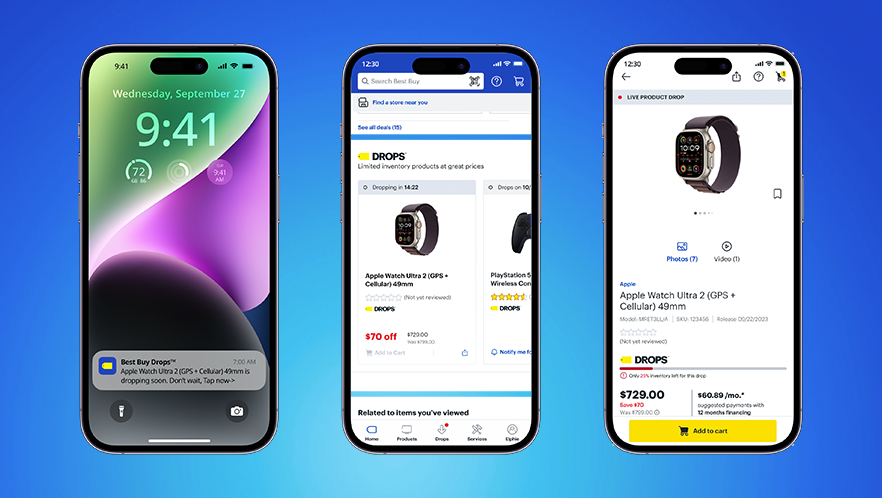
The app transcends simple product browsing. It offers features like:
- Access to deals, curbside pickup setup, order updates, and more.
- Personalized recommendations
- Augmented reality (AR) to visualize products in your space, store maps for easy in-store navigation, and product alerts to notify users of price drops on the desired item
- Order tracking and fast checkout
- Benefits for My Best Buy Memberships
Tailored customer experience
Best Buy goes beyond a one-size-fits-all approach. They leverage customer data and analytics to provide targeted promotions and personalized recommendations. This ensures customers receive relevant information about products and services that align with their specific needs and interests.
Extensive use of customer data and analytics
The company analyzes customer data, market trends, and performance metrics to identify areas for improvement and innovation. By leveraging data-driven decision-making, Best Buy ensures that its technology investments are strategic, impactful, and aligned with customer expectations, ultimately enhancing the overall customer experience. Best Buy doesn’t just collect customer data; they translate it into actionable insights. This data is used for:
Data-Driven Decision-Making: Best Buy’s extensive use of customer data and analytics is a testament to its commitment to strategic innovation, a practice endorsed by industry leaders such as Gartner and Forrester Research.
Strategic Technology Investments: Reports from respected sources like The Wall Street Journal and McKinsey & Company highlight how companies like Best Buy strategically invest in technology, guided by data insights, to enhance customer experience and drive business growth.
Actionable Insights: Best Buy’s approach of translating customer data into actionable insights mirrors the recommendations of leading experts like the International Institute for Analytics, emphasizing the importance of actionable data in driving business success.
Personalization and Targeted Marketing: Crafting targeted marketing campaigns that resonate with specific customer segments, maximizing campaign effectiveness. The effectiveness of personalized marketing campaigns, driven by customer data, is well-documented by studies published in journals like the Journal of Marketing and Harvard Business Review, showcasing how tailored approaches resonate with specific customer segments.
Demand Forecasting and Inventory Management: Predicting product trends and ensuring optimal inventory levels to meet customer needs and avoid stockouts. Best Buy’s utilization of data for demand forecasting and inventory optimization aligns with best practices outlined by organizations such as the Retail Industry Leaders Association (RILA) and the National Retail Federation (NRF), emphasizing the importance of data-driven approaches in managing supply chain dynamics and meeting customer demand efficiently.
Store layout optimization: Analyzing customer traffic patterns to optimize store layouts for a more intuitive and efficient shopping journey.
Geek Squad services
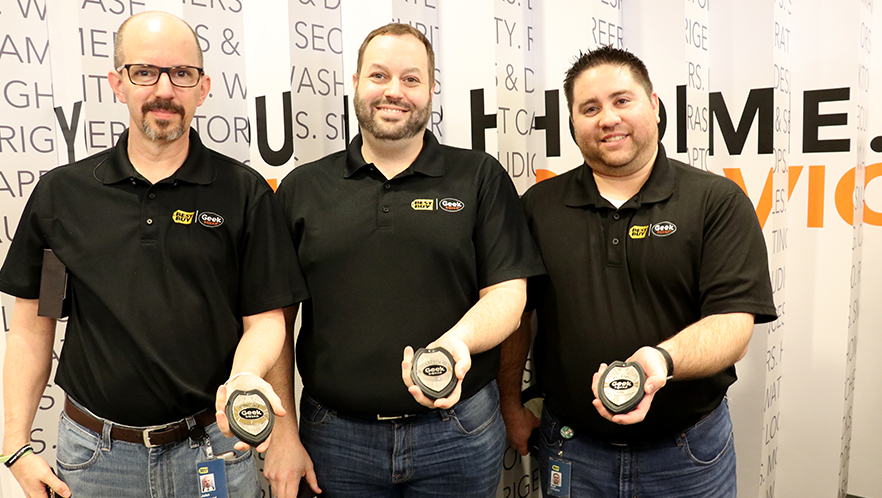
Best Buy recognizes that tech products often require installation and support. The Geek Squad provides a comprehensive suite of services, including product setup, troubleshooting, and repairs. This value-added service differentiates Best Buy from competitors and builds customer confidence.
My Best Buy program
The My Best Buy program goes beyond traditional loyalty programs. It offers tiered benefits such as exclusive discounts, free shipping, extended return windows, and early access to sales events. This incentivizes repeat purchases and fosters stronger customer relationships. Specifically, the Best Buy Visa Credit Card awards consumers with points for purchases both inside and outside of Best Buy.
- Enhanced Loyalty Program: Best Buy’s My Best Buy program stands out among traditional loyalty programs, offering tiered benefits that go beyond mere discounts, as recognized by industry experts such as Retail Dive and Forbes.
- Exclusive Benefits: The program’s tiered benefits, including exclusive discounts, free shipping, extended return windows, and early access to sales events, have been praised by authoritative voices in retail, such as RetailWire and Business Insider, for their effectiveness in driving customer engagement and retention.
- Incentivizing Repeat Purchases: The My Best Buy program incentivizes repeat purchases through its tiered benefits system, a strategy endorsed by renowned marketing scholars like Philip Kotler, highlighting the program’s role in fostering stronger customer relationships and driving long-term loyalty.
- Best Buy Visa Credit Card Rewards: The integration of the Best Buy Visa Credit Card into the My Best Buy program, which awards consumers points for purchases both inside and outside of Best Buy, reflects best practices in loyalty program design, as advocated by experts in the field of customer relationship management (CRM) and loyalty marketing.
Store layout changes
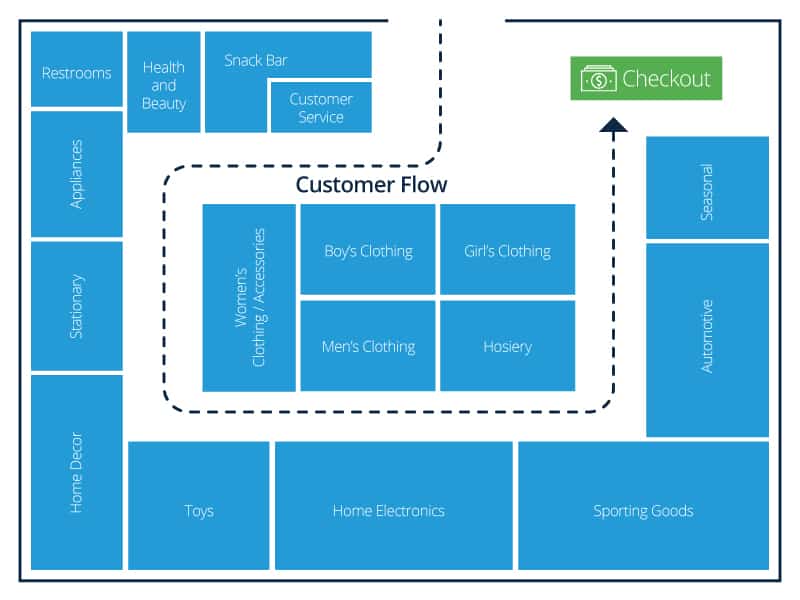
Best Buy has reorganized its store layouts to optimize them for eCommerce operations, focusing on reducing in-store storage space and utilizing it for ship-from-store deliveries and in-store pick-ups. By adapting its physical stores to support eCommerce fulfillment, Best Buy enhances its operational efficiency and improves the overall customer experience
- Operational Optimization: Best Buy’s strategic store layout changes align with recommendations from industry leaders such as Deloitte and Bain & Company, emphasizing the importance of adapting physical spaces to support eCommerce fulfillment for improved operational efficiency.
- Efficient Fulfillment: Reports from reputable sources like The Wall Street Journal and Harvard Business Review recognize the benefits of utilizing in-store space for eCommerce operations, citing examples of how this approach can lead to faster delivery times and enhanced customer satisfaction.
- Customer-Centric Approach: Best Buy’s focus on improving the overall customer experience through store layout changes mirrors best practices outlined by organizations such as the National Retail Federation (NRF) and the Retail Industry Leaders Association (RILA), which emphasize the importance of aligning physical and digital retail channels to meet evolving consumer expectations.
- Adaptation to Changing Retail Landscape: By reorganizing store layouts to support eCommerce fulfillment, Best Buy demonstrates agility in response to the evolving retail landscape, a strategy endorsed by experts like McKinsey & Company and the Wharton School of the University of Pennsylvania, which highlight the importance of flexibility and innovation in maintaining competitiveness.
Digital marketing strategy analysis of Best Buy
Best Buy creates a cohesive digital marketing experience by strategically combining various tactics. They provide valuable content, target customers effectively, and nurture relationships through personalized communication, ultimately driving online sales and in-store visits. Here’s a breakdown of their key tactics across various channels:
SEO & content marketing

- Targeted content: Best Buy creates informative content like buying guides, product comparisons, and blog posts that address customer queries. This content is optimized with relevant keywords to improve search engine ranking and organic traffic.
- Local SEO: They optimize their website and online stores for local searches, ensuring customers can easily find nearby locations and their specific product availability.
Paid advertising marketing
- My Ads: The company’s self-service ad platform, My Ads, enables brands to purchase, plan, monitor, and manage their campaigns, providing detailed insights for optimization based on various criteria like time, products, and ad placement
- Search Engine Marketing (SEM): Best Buy strategically utilizes paid search ads to appear at the top of search engine results pages when relevant keywords are searched. This ensures their offerings are prominently displayed to potential customers actively researching products.
- Display advertising: Targeted display ads reach customers across various websites, showcasing relevant products and special offers.
Social media marketing
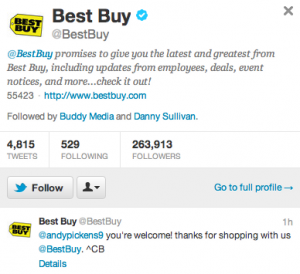
- Active presence: Best Buy maintains a strong presence on major platforms like Facebook, Twitter, and Instagram. They use these channels for:
- Product launches and promotions.
- Educational and entertaining content (think tech tips and reviews).
- Customer service interactions and engagement.
- Influencer marketing: Partnering with relevant tech influencers allows Best Buy to tap into established audiences and leverage their credibility for product promotion.
Email marketing
Best Buy employs email marketing as a part of its digital strategy to communicate with customers, promote products, and drive conversions. By leveraging email campaigns, Best Buy can deliver personalized messages, offers, and updates to its subscribers, enhancing customer engagement and retention.

ATL marketing strategy analysis of Best Buy (Above-the-line)
This strategy focuses on mass communication methods that target a wide range of consumers, aiming to generate interest and drive traffic to Best Buy stores or online platforms. Some key points about Best Buy’s above-the-line marketing strategy include television, radio, outdoor and print advertising.
In-store strategy analysis of Best Buy
Best Buy understands that the physical store remains a crucial touchpoint in the customer journey. Let’s delve into the key elements of their in-store strategy that orchestrate a positive customer experience and drive sales:
- Physical store presence: Best Buy strategically locates its stores in prime locations to attract higher foot traffic. The company has a significant physical footprint in the United States, with a focus on offering an omnichannel shopping experience that integrates online and offline channels effectively
- Customer experience enhancement: Best Buy invests significantly in training its staff to provide expert advice and create an in-store experience that sets it apart from competitors. By focusing on enhancing the customer experience through knowledgeable staff and personalized service, Best Buy aims to build strong relationships with customers and drive loyalty
- Buy-Online-Pickup-In-Store (BOPIS): Best Buy has a unique BOPIS strategy where all its stores are utilized to ship online orders, with a high percentage of online order returns completed in-store. Additionally, the company has established pickup points in UPS and CVS locations for online customers, leading to a significant increase in BOPIS transactions. This strategy enhances customer convenience and flexibility in fulfilling their orders.
- Cost management and efficiency: Best Buy focuses on cost management strategies to maintain competitive pricing and improve profitability. By negotiating with suppliers, controlling inventory, and optimizing supply chain management practices, the company ensures efficient operations and cost-effective delivery of products to stores. This emphasis on operational efficiency helps Best Buy remain competitive in the retail industry
eCommerce strategy analysis of Best Buy
Home page analysis

What we liked
- Easy-to-use navigation
- Not cluttered graphics
- Prominently displays of the latest deals on products
- Virtual shopping experience where customers can connect with experts through chat, video, or audio calls for personalized assistance.
- Effective CTAs featuring the Geek Squad service, expert advice, tips, and tricks to enhance the shopping experience.
- Clean, spacious, and visually attractive, drawing attention to products and offering clear navigational paths throughout the site.
What we didn’t
- The site’s design could be improved to ensure a more intuitive and visually attractive layout, especially when compared to competitors like ABC Warehouse and CompUSA.
Category page analysis

What we liked
- User-friendly interface with clear navigation options
- Well-organized page layout
- Detailed product information, and customer reviews
- Filters and sorting options for refined search results based on specific criteria
- Comprehensive selection of products
What we didn’t
- The loading speed could be improved to enhance the overall user experience, especially for customers with slower internet connections.
- Mobile responsiveness optimization needed
- Additional interactive features or visual elements would be beneficial
- More robust and accurate search functionality, allowing customers to easily find specific products within the category.
Product page analysis

What we liked
- Detailed product information, specifications, Q&As, and customer reviews, aiding customers in making informed purchase decisions.
- High-quality product images and videos on the product page enhance the product’s visual representation.
- Delivery or pickup option
- Variety of products across different categories on the product page, catering to a wide range of customer needs and preferences.
- Clear pricing information, promotions, and deals, making it convenient for customers to compare prices and find the best offers.
- Product comparison tools, wish lists, and related product suggestions
What we didn’t
- The product page layout could potentially be improved to make it more visually engaging and intuitive
- Enhancing the mobile responsiveness for consistency
- Additional customization options, such as personalized recommendations based on customer preferences or past purchases.
- More interactive elements like 360-degree product views or augmented reality features.
Checkout page analysis

What we liked
- Streamlined and easy checkout process
- Clear and transparent pricing, including taxes, shipping costs, and any additional fees,
- Multiple payment options on the checkout page
- Order summary details, itemized lists of products, quantities, and prices
- Security features and trust signals, such as SSL encryption and secure payment gateways
- Guest checkout
- Price match guarantee
- Cross-sell options
What we didn’t
- Could include some additional customization options, such as delivery date selection, or gift-wrapping services
- No exit-intent pop-ups or incentives on the checkout page to reduce cart abandonment rates and increase AOV
- Could be more intuitive, guiding customers through the checkout process seamlessly and reducing friction points that may hinder conversions
Interesting statistics about Best Buy
Here are the latest key statistics regarding Best Buy:
- Best Buy’s annual revenue for the fiscal year ending February 3, 2024, stood at $43.45 billion, marking a decrease of -6.15% compared to the previous year.
- In the quarter ending January 31, 2024, Best Buy reported a revenue of $14.65 billion, reflecting a -0.60% decrease year-over-year.
- The company’s current market capitalization is recorded at $17.39 billion.
- Best Buy maintains a workforce of approximately 85,000 employees.
- On average, each Best Buy employee contributes $511,200 in revenue.
- Best Buy’s revenue history exhibits fluctuations, with the most recent figure recorded at $43.45 billion in 2024.
- Notably, Best Buy experienced a significant growth of 33.2% in online sales for Q1, 2022, compared to 15% in Q1, 2020, particularly driven by home theater, computing, and appliances.
- The company has implemented a ship-from-store hub model to manage online order fulfillment efficiently, with 70% of online orders directly processed from the stores.
- Best Buy boasts over 80,000 cross-trained employees and more than 20,000 highly skilled Geek Squad agents dedicated to delivering exceptional customer service.
- To accommodate increased demand during peak periods, Best Buy extended its sales period, ensuring smooth supply chain operations and providing customers with more time to take advantage of special offers.
Latest news about Best Buy
- For 11th year in a row, Best Buy named ENERGY STAR Partner of the Year
- Best Buy Announces Retirement of Board Chairman J. Patrick Doyle, Appoints David Kenny
- Best Buy (BBY) Gains on Efforts to Enhance Customer Experience
- Best Buy named to World’s Most Ethical Companies® list for 10th year
Discover more retail case studies like Best Buy’s
- Chewy Marketing Strategy: How the US Pet Retailer Redefined the Industry Standards
- How ZARA Dominates the Ecommerce Fashion Industry
- Why ASOS is the Absolute UK Ecommerce Success Story
- New Look: The Marketing Strategy Behind the UK Fast-Fashion Retailer
- Farfetch Case Study: Analyzing The Strategy of the UK Fashion Unicorn
- The Marks and Spencer eCommerce Case Study: 3 Growth Lessons for Retailers
- SUPERDRY Case Study: The Marketing Strategy Behind One of the Top UK Clothing Retailers
- Macy’s Marketing Strategy: How the Omnichannel Clothing Retailer Scaled
- The Ocado marketing strategy: How it reached the UK TOP50 retailers list
- ASDA’s marketing strategy: How the British supermarket chain reached the top
- Tesco Case Study: How an Online Grocery Goliath Was Born
- ALDI’s marketing strategy: The key growth ingredients of the FMCG titan
- Walmart Marketing Strategy: Decoding the Success of the US Multinational Retailer
- Analyzing Lidl’s Marketing Strategy: How the Discount Supermarket Leader Scaled
Interested in copying Best Buy’s marketing strategy? Let’s talk.
Best Buy exemplifies a dynamic and adaptive approach, expertly navigating the ever-shifting retail landscape. By prioritizing customer-centric strategies, embracing technological advancements, and implementing efficient operational models, they’ve secured their position as a leading consumer electronics retailer.
Through initiatives like omnichannel integration, strategic acquisitions, and a focus on enhancing the in-store experience, Best Buy has effectively responded to challenges and capitalized on opportunities. This approach drives growth and maintains its relevance in a highly competitive market. As the retail landscape continues to evolve, Best Buy’s case study serves as a powerful testament to the importance of agility, innovation, and a customer-centric focus in achieving long-term success.

Let’s Help You Scale Up





